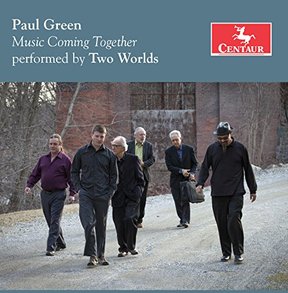
Green’s musical wedding party is comprised of pianist Alan Simon (Dizzy Gillespie, Toots Thielemans, Lee Konitz), alto and tenor saxophonist Bruce Krasin (Tony Bennett, Jeff Holmes), drummer Bill Chapman (John Medeski, the Berkshire Jazz Collective), bassist Daniel Broad (The Drifters, The Platters) and guitarist Michael Musillami. The album was produced by Paul Green himself.
The album opens with Tarras Doina and Blues by Dave Tarras, the great Klezmer clarinetist. A doina, explains Green in the liner notes, is “a rhapsodic klezmer form, free and expressive, and usually without meter. Green took a fragment of Tarras’ original and morphed it into a minor blues. Green’s bluesy, transcendental clarinet brings home the melancholy but there are moments of pure delight as the guitar helps to take the blues away. Simon’s piano is, as I said above, precise. This song sets the hook for all that follows.
Si La Mar Era de Leche (If the Sea Was Made of Milk) is a lovely Sephardic Jewish melody. The Sephardic Jews were expelled from Spain in 1492, when the Muslims were also tossed out. A nod and a wink to Bach was an added element. That haunting clarinet is accompanied by the single drum to open the piece and is soon joined by the piano then bounces off the guitar. The artistry of Green, Simon and Musillami are astonishing.
Then comes the amazing treatment of Wayne Shorter’s Footprints into Yiddish Footprints. The original 12-bar blues is transformed into something livelier, even euphoric. Daniel Broad’s bass carries that sweet groove and lays the groundwork for all that melody above it.
Miles Davis’ So What? becomes So, Nu? What was Miles’ move away from Bebop, becomes a chance for Green to move in the direction of assimilation between Miles’ Dorian mode and the Jewish Misheberakh mode. That change is slight but so effective. Instead of Miles and Trane, Green and Bruce Krasin carry the melody and Simon is solid as the rhythm section works the familiar groove. Krasin’s Jewish Trane is very attractive. What a fun piece!
Rodgers and Hart’s My Funny Valentine is rendered as My Funny Jewish Valentine and is carried as a duet between clarinet and piano. The melodies stay largely intact but they are shifted with Jewish scales that produce a less melancholic, but more meditative, tune.
Interspersed between the Jazz standards are tunes not so familiar to a non-Jewish audience. They are taken from their original element and treated lovingly with Jazz intonations and modulations. Green made me search for (and find) the originals and—just as Green had said—it was easy to hear the contributions of Jewish music to the great American songbook.
What Paul Green has done with Music Coming Together is that the Jewish community and the Jazz community owe so much, artistically, to one another. The earliest Jazz was taken by the Jewish Jazz composers, run through the Jewish musical spectrum and returned to the African-American Jazz masters, who worked it over once again to fit it for themselves. Green states that he intended to unite two different worlds. The Jewish community and African-American community found themselves at odds throughout the 20th Century but the thing about Jewish and Jazz music is that they both work towards resolution. Music can bring anyone together. Jazz can bring everyone together.
~Travis Rogers, Jr. is The Jazz Owl
 RSS Feed
RSS Feed
